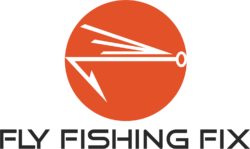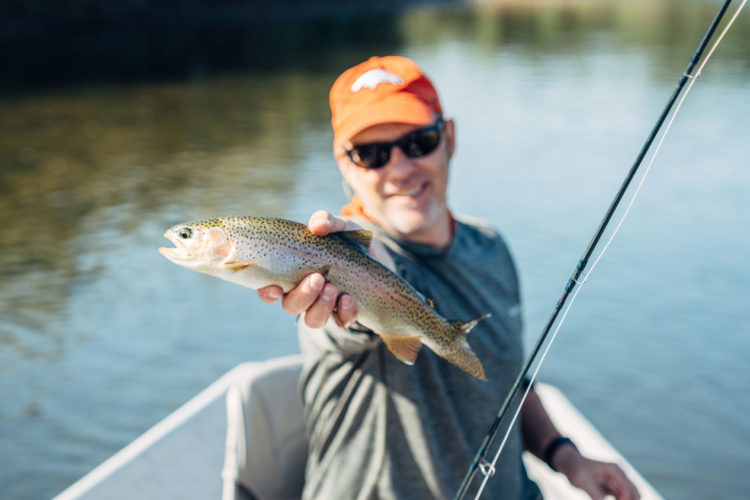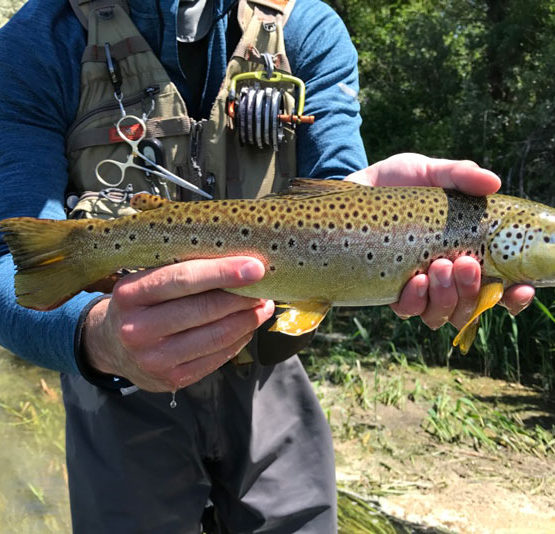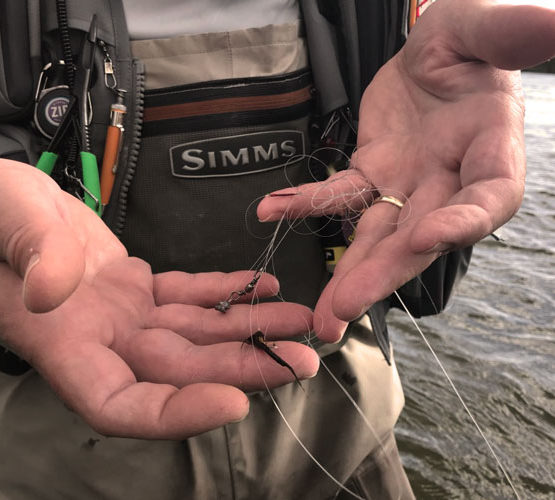When it comes to fly fishing, there is a lot to discover. And when you are just starting out, it can get a little overwhelming. So, in this article, we are going to cut through the noise and get right to the point. Here are 9 things to learn about fly fishing.
I think this may be a universal truth. At some time in your life, sitting in a classroom somewhere, you’ve had this thought about something you were learning: When will I ever use this? I’ve felt that way about a lot of things… trigonometry, calculus, Pavlov’s dogs, to mention just a few.
Alternatively, when learning in a discipline you enjoyed, or in one that at least clicked for you, that thought never came up. Other than standing in a beautiful river, trying to land a hard-fighting rainbow late on a sun-splashed afternoon, that’s what I think I love most about fly fishing: it presents an endless arena of engaging, applicable learning with rather satisfying educational reinforcements along the way.
From the moment you lay that sweet cast, see that fish attack your well-drifted fly (or feel that tug and wriggle of a subsurface take), you’re a goner. Heck, you don’t even have to net it to get the immediately addictive adrenaline rush a fish-on situation triggers. And from then on, the learning may never stop.
Even better, you probably won’t want it to.
So, if you’re ready to accept and embrace your obsession — and what’s stopping you, really? — here are 9 important things to learn about fly fishing.
Related Content:
- When Is Fly Fishing Season?
- How Long Does Tippet Last? (Plus 5 Tips To Make It Last Longer)
- 9 Killer Nymphing Tips For Beginners
- Can You Fly Fish Anywhere?
- Head Cement vs. Super Glue: What’s The Difference?
1. Learn About Basic Fly Fishing Equipment (Rods, reels, vest, boots, waders, line, tippet etc.)
In a previous post, I expounded upon the essential equipment every fly fisher will need to gather to make their foray into the sport less difficult. However, I made virtually no point about how much fun you can have exploring the various pieces of equipment, the myriad of different configurations and setups and the wide array of manufacturers that occupy every corner of the fly fishing equipment industry.
When I first started to indulge my obsession (as an adult with at least some expendable income), it wasn’t unusual to catch me in deep study of the Orvis catalog.
At first, I did this in secret: on the throne with the fan running; in my office with the doors closed; under the covers with a flashlight. But before long, I had multiple catalogs, fly fishing magazines and other such literature strewn about the coffee table, right out in the open, where I could look at them anytime I wanted to.
Suffice to say, I found them all very educational and, during those heady days of early learning, it became fairly typical to interrupt serious conversations with my wife with something like, “Say, hon, I’m really sorry about how you’re feeling about that problem you’ve been having at work, but, did you know that weight-forward line and 5X tippet spools are on sale this week at The Denver Angler?”
I don’t recommend such ill-timed inquiries, but catalogs, magazines, brochures and pamphlets can be a wonderful source of both early and ongoing learning about basic fly fishing equipment and the sport’s seemingly endless conveyor belt of innovative products.
2. Learn About Fly Fishing Gadgets
Closely associated to the above, but deserving of its own category, fly fishing gadgetry presents a veritable smorgasbord of cool stuff every fly fisher will want to learn about. Indeed, the gadget wall at any good fly shop is where human ingenuity is on full display. While competing for space with the industry’s brand new must haves, decades-old standbys hold their place among more recent variations thereof and, well, can you say eye-candy? What’s more, most of them have really cool lingo-y names. From tippet spool holders, nippers, floatant holders, zingers, and forceps, to line-straighteners, knot-tiers, lanyards, thermometers, stomach pumps, and strike indicators, the fly fishing gadget addiction is one that, once indulged, is hard to come back from. That said, learning about all the expansive variety of make-your-life easier fly fishing tools is yet another rather engaging field of study.
3. Learn About Fly Fishing Clothing and Gear
Come Christmas, my birthday, Father’s Day, Matt-Appreciation Day or any other occasion prompting the convention of gift-giving, I request, and get, gift cards to my favorite fly shop. In the accumulation of these, you can imagine how nice a fly-fishing war chest I’m able to build each year. Every Spring, I blow the whole thing at a big event and sale they put on.
This past year, I found myself in weird, uncharted territory… I literally had everything I truly wanted! Since I’ve done this every year for quite some time, there was nothing so new, so innovative, so, well, sexy (in a fly-fishing sense) that I felt compelled to buy. I guess I could have foregone buying something altogether, continued my “saving” and bought something later, but, instead, I doubled up on sun shirts, neck buffs, under-layers, hats, gloves — both the kind for sun protection and the kind for warmth — rain gear and an assortment of other things I already had.
Oh, yeah… I got this killer thermos. That was new.
What’s my point? I really don’t have one, except to say that one of the most fun things about fly fishing is learning about and building your arsenal of gear, gadgets and clothing.
For instance, last year — knowing full well that the weather service was predicting balmy highs of between 10 and 15 degrees — I went on a fly fishing trip with a friend in Wyoming. When I came to the lobby of the hotel the first morning (yes, there was more than one morning… we’re idiots) the guide was jealous of my nano-fiber under-wader pants.
I try really hard not to be “that guy,” but, I can say without a small bit of pride, it did feel good to be ahead of the cold weather clothing curve that day! And it’s been a load of fun learning about, and adding to my stock over the years. You’ll have fun too.
4. Learn About Fly Tying
Fly fishing purists — those who tie their own flies — have an elitist air about them. Frankly, this can be both off-putting and jealousy-inducing for guys like me who apparently don’t have a lick of the concentration, dexterity, patience and creativity, okay, let’s call it the GIFT to be good fly tiers.
Truth be known, I’m fascinated by the art of fly tying but, apparently, I’m that much more fascinated by the art of fly buying, and damn if I’m not really good at it! Born of FONH (Fear of Not Having) every fly I could possibly need in any and all situations at all times, it’s a wonder my collection of full-to-the-hilt fly boxes don’t need one of their own bays in my garage.
You’d think I’d have learned to tie one or two along the way, wouldn’t you? I tried. I did! I really did! But, as I watched my son take to it as if there was a gene in his DNA labeled fly-tier, I just couldn’t quite get it.
The fly-tying aspect of fly fishing is a world of learning unto itself. In other words, many find the same peace and passion in fly-tying as they do in fly fishing. Some find more. I’ve even known an old fly fishing sage or two who didn’t even fish anymore. These guys were content peering through a magnifying glass, readers up, focused on their vice, honing their tying skills, creating new patterns, and teaching the skill to others. Maybe I should make an appointment with one of them. I’m not getting any younger!
If you want to learn about fly tying, be sure to check out our post: Fly Tying For Beginners (The Ultimate Guide).
5. Learn About Casting Techniques
I’ve been casting a fly rod almost as long as I’ve been able to tie my shoes and yet, I just watched what was probably my seven-hundredth video about fly casting techniques, fly casting variations, fly casting in different conditions, and fly casting tips. I think there was even one in there that showed how to make a good cast without spilling your beer, but I didn’t learn anything new in that one.
My dad used to say that he wasn’t sure what felt better: putting a good swing on a golf ball, hitting it center-screws, and watching it split the fairway a few hundred yards away, or making a perfect dry-fly cast to a feeding trout, watching the fly alight delicately, exactly where you wanted it to, and seeing the targeted fish attack it with a ferocious thrash. Dad had a good swing and an even better cast, so I’m pretty sure which feeling won out. For me, piping a drive is certainly a great feeling, but a rewarded cast beats it a hundred time out of a hundred.
Once you’ve learned the basics of a standard dry-fly cast (and begin to catch fish with it) you’ve only just begun. Soon, driven simply by the desire to catch more fish, you’ll be eager to explore how many different casting variations there are and when to use them. From the standard roll-cast to the double-haul to the Belgian streamer cast and many other methods and variations in-between, learning about fly casting is yet another arena of lifelong study. The good news is that there are thousands of instructional videos out there and, unless practicing off river, you’ll be able polish your techniques while indulging your passion of catching fish on a fly. No driving range necessary.
6. Learn How To Rig Your Fly Rod
Another essential element of the catch-more-fish equation is rigging. The fly fishing rig you’ll use is determined by different fish species, situations, conditions, locales and more, however, assuming you’ve already chosen the desired rod/reel and basic line combination for the situation, rigging generally refers to the business end of the fly fisher’s presentation… In other words, the line, knotting, weighting, indicator and imitation fly setup you’ll use to fool your aquatic quarry.
I just got back from a fishing trip with a buddy and, between us, within two and a half days, we undoubtedly changed our respective rigs well over a hundred times each! We were fishing three different rivers that, though within the same vicinity, required different rigs and rig variations, and these changed depending upon what we were trying to do, what the conditions demanded, what time of day it was, what kinds of flies we were seeing on the water, what we were experimenting with, and a great deal more. When you’ve found the right rig — and, believe me, you’ll know when you have — you won’t need to change it often.
In other words, my friend and I clearly didn’t figure out what the trout were eating during our trip, but it was sure a fun challenge to try!
7. Learn About Fly Presentation
Closely akin to rigging is what happens to your rig when you’ve finished fumbling around with it and have actually cast it into the water. Depending upon where you’re fly fishing and, of course, the conditions, our fine finned friends can be surprisingly smart and, therefore, as selective as a six year-old at a Sunday brunch. Throw a fly at ‘em that doesn’t look natural and your chances of catching drop to near zero. Not that he or she will ever admit to it at the moment, every fly fisher catches a random-lucky every so often.
In fact, here’s a sentence you won’t hear on the river very often: “Man! I don’t have the faintest idea how I caught that one!” But learning about fly presentation is really where the money is, and if you commit to perfecting your presentations, you will simply catch a lot more fish.
Let me illustrate.
One early summer day on the Bighorn River, my son and I had tucked our boat into a quiet cove, within respectable site of a particularly productive run we like to fish, and waited our turn as another father and son pair (who had gotten there first) fished it. While we munched sandwiches and sipped a couple cold ones, we took turns gazing at the soaring eagles above and at the poor presentation efforts from the two gents in front of us. We don’t claim to be the world’s best fishermen, but as we both watched, we knew full-well that neither of these guys was going to hook up on, nor land a single fish. Not in that particular hole for sure, and probably not all day.
At the time of the year we usually fish it, the Bighorn river runs with a fair amount of rather pesky underwater moss. As you can certainly imagine, clingy moss and things with hooks on them don’t exactly marry up well. Since trout simply won’t hit a fly with either a small or large glob of moss dangling from it, one must either manually clean off his or her flies between every cast, or, as we had learned early on, employ a swirling whip-style casting technique — known as “The Bighorn Slap” — between each cast to quickly and easily rid rig, line and flies of the green goo before presenting same to said trout on subsequent cast. Put simply, goopy flies = no fishy.
So, since at no time did we see these two do anything to clean their flies, we knew that, even if they had done everything else right — read the water well, matched the hatch, made casts to the right locations, mended lines for drag-free drifts, etc. — there wasn’t a chance in hell of a single hook up, let alone a grip-and-grin photo with a joyously fought and netted rainbow.
Clearly discouraged, they mounted their rafts and pushed on while we moved in, anchored up, and proceeded to catch somewhere in the neighborhood of thirty-five to forty fish within two hours, right out of the same hole. The moral of the story? A simple, overlooked, and easily-corrected presentation mistake can mean the difference between an epic, multi-fish day on the water and a forgettable skunker!
So, since at no time did we see these two do anything to clean their flies, we knew that, even if they had done everything else right — read the water well, matched the hatch, made casts to the right locations, mended lines for drag-free drifts, etc. — there wasn’t a chance in hell of a single hook up, let alone a grip-and-grin photo with a joyously fought and netted rainbow. Clearly discouraged, they mounted their rafts and pushed on while we moved in, anchored up, and proceeded to catch somewhere in the neighborhood of thirty-five to forty fish within two hours, right out of the same hole. The moral of the story? A simple, overlooked, and easily-corrected presentation mistake can mean the difference between an epic, multi-fish day on the water and a forgettable skunker!
Learning about, and perfecting a wide variety of fly fishing presentation techniques is yet another arena of lifelong learning that carries with it a stunningly addictive, yet (mostly) healthy set of rewards. Any questions?
8. Learn About Fly Fishing Entomology (The study of insects) – The trout ecosystem
Harkening back to an earlier theme, although I generally enjoyed science classes, I often wondered how I would use the information they were teaching me in my actual life. I mean, how many of us really need to know the atomic number of Dysprosium? (It’s 66, in case you care.)
Nevertheless, what self-respecting boy didn’t love looking at a paramecium under a microscope or watching the dutiful goings on of a big anthill just before dropping a nuclear bomb (a seven-year-old foot) on their entire city? Well, along came fly fishing and the weirdly captivating study of the ecosystem of trout and, more specifically, the entomology of the aquatic-born fly.
And since it’s fly fishing, would’t you know that different types of flies have different metamorphic stages, each of which a good fly fisher has learned to closely observe and identify to help explain why feeding fish behavior may differ depending upon, you guessed it, time of year, time of day, weather conditions, water temperature, depth, humidity, and several other factors.
Loosely, in fly fishing parlance, knowing aquatic fly entomology and the associated feeding behaviors of fish is known as “matching the hatch.” You’ll know that you’ve gone off the deep end when, at your next outdoor cocktail party, just after a light rain storm passes by and a swarm of tiny flying insects is suddenly pestering your date, instead of suggesting the two of you go inside for another cocktail, you find yourself droning on about the fascination you have about this sudden midge hatch. What’s more, you may not even care that you’ll now be talking to yourself.
9. Learn How To Read The Water
In the words of the Rain Man, “I’m an excellent driver.” Although my wife might disagree, I truly believe this about myself, that is, until I’m driving next to a river. Whether a large tailwater, a freestone creek or a mountain brook, put me next to such a flowing body of water and my gaze is immediately and involuntarily drawn to its bends, runs and riffles.
I’ll say things like, “Oooohh, honey, check out that deep run just below that bend.” And she’ll reply with gentle sentences like, “WATCH OUT FOR THAT BRIDGE ABUTMENT!”
At a very young age, my dad taught me how to read a river. With me, rod in hand, eagerly and anxiously waiting at his side, we’d stand at a certain distance from the section of river we were about to fish while, like some sort of Native American spirit guide, he’d study it… let it speak to him.
Based on flow pattern, cover, oxygenation and depth, he’d point out the most likely fish-holding channels. He’d let sun position, shadowing, wind, and the likelihood of backcast snags dictate our approach. He’d watch for surfacing fish, whether they were high, low, left or right in the run and how they were behaving. He’d observe what was flying around our heads, while deciding how stealthy we would need to be to reduce the chance of spooking our quarry. Then, and only then, would he point his rod to where he’d want me to position myself and advise me how I should cast and drift my fly.
As impatient as I could be, I loved it. He was Yoda. I was Luke. And nine times out of ten, if I executed according to his instruction and didn’t stumble, splash, snag or otherwise wreck the run, I was rewarded.
Over time, reading water, as he did, became second nature to me and, with every new experience, translated into greater and greater fishing success.
Like many other things fly fishing, learning to read water and, more accurately, what it is about a certain river section’s structure, flow depth and other environmental factors that causes hungry fish to congregate in certain spots, is yet another arena of obsessive fly fishing study.
Final Thoughts
In writing this post, three things have become very clear to me: 1. I’ve learned a lot about fly fishing over the years, 2. It never felt anything remotely like school and, 3. I can’t wait to keep learning more about it!
Most every avid fly fisher I know would echo the following sentiment. The pursuit of fishing can be, all at once, sublimely peaceful, maddeningly elusive, mentally consuming, spiritually fulfilling and, of course, strangely and powerfully addictive. Although they might not realize it or give it this level of thought, most would also admit that, when it comes to fly fishing, the learning is just about as fun as the catching.
Disclaimer: This post may contain affiliate links, meaning we will receive a small commission (at no cost to you) if you click through and make a purchase.









